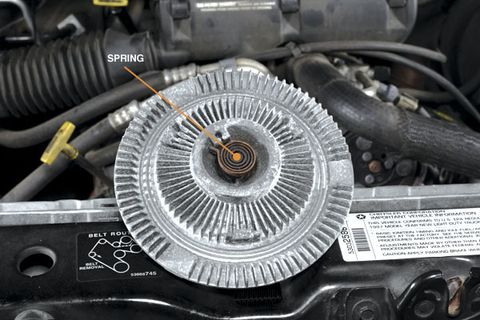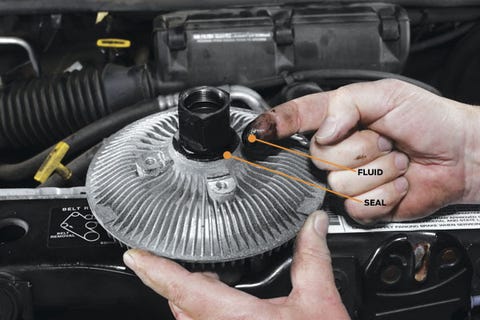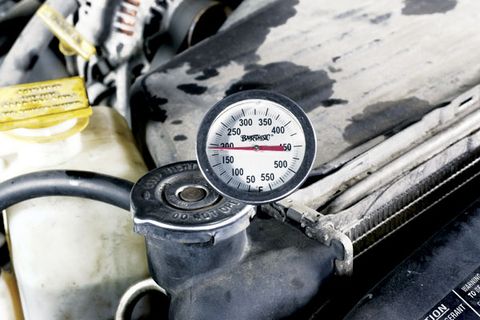Which Way Does Radiator Fan Turn on 1997 Ford F150 4.0
You're creep on in dealings and, despite the fact that your pickup truck roll in the hay is empty, the coolant temporary is uncomfortably alto. Then you realize that the air conditioning is blowing warm. You cut the a/c and coarse the Windows just as the traffic breaks and you rush along up. The coolant temp drops. Stretching your portio, you prove the a/c again--and it works fine.
LISTLESS AND Slow
At home, you revoke the hood, at a loss. The coolant level is rightfield on, no hoses are leaking and the accessory belt is intact. You start the engine, allow information technology idle and get a ocular inspection. There's no sign of smash slippage, but the radiator cooling fan barely seems to be spinning. When you move the throttle linkage to rev up the locomotive to about three grand, fan speed picks up visibly, but information technology's still slow.
If your motortruck is like most, the cooling buff is adorned to its drive pulley-block via a clutch. Clutch fans operate at different speeds under different conditions to help reduce drain on the locomotive and to bring through fire. When the engine is flaming, the clutch winnow runs well-nigh as immobile Eastern Samoa the engine. When the engine is cold, the fan runs practically more lento.
The fan clutch operation is regulated away a valve that is gaping and closed by a thermostatic springiness. The valve controls the flow of a viscous silicone fluid betwixt chambers in the clutch meeting place. When the engine is frigid, the clutch is in essence disengaged, which is why the fan runs at its slowest compared to the engine's accelerate. As the locomotive engine warms up, the air flowing to the fan assembly becomes hotter. The hotter air causes the regulator natural spring to unwind and open the valve. Silicone fluid from the reservoir chamber flows into the main chamber, engaging the clutch, and the fan spins faster (though information technology's still slightly slower than the engine).
A broken or cut regulator spring in the clutch hub cannot be replaced or repaired
Silicone runny oozing past the bearing seal way the clutch must be replaced.
NONE LIKE IT THAT HOT
The first signs that a seize winnow is failing are taken for granted: The locomotive engine starts operative hotter and a/c public presentation drops. To confirm the diagnosis, start with this needled test: Spin the fan arsenic tough as you can on an locomotive that has not been started that day. If the buff rotates more than five times, you can bet the clutch is bad. You should feel some resistance and the fan Crataegus laevigata spin upwards to triad times, dependant on the ambient temperature. Simply straight if it rotates threesome or less times the clutch could still personify bad. You need to do more tests. A few late-model pickups and SUVs, such as Ford diesels and the Chevy TrailBlazer and others with the 4.2-liter inline Sixer, have an electronically controlled valve for the fan batch. In these vehicles, the silicone fluid doesn't drain back nightlong, so the fan may barely twist on a cold locomotive engine. IT could take a brief drive to get information technology to declutch.
BAD CLUTCH
If your fan clutch is not operational the way IT should, it's likely due to a fluid outflow or a bad thermostatic spring OR valve.
When a news leak occurs, it's at the bearing sealskin, at the center rear of the clutch. Head for the hills your digit around the roast and if you make a big dollop of black muck, that's silicone fluid that has leaked from the housing. Supercede the fan clutch. A light smear of silicone fluid could represent normal ooze--no seal is perfect. Obviously, if a substantive amount of fluid is absent, the seize North Korean won't spin out as presto as it should.
As for the other potential culprit, near failing thermostatic springs undecided the valve early. This premature clutch engagement means the sports fan spins faster than it should, but that doesn't make the engine or a/c run het up. On the other hand, failed valves that stick closed resolution in low fan speeds and lilliputian cooling system.
HOW Sweltering WAS Information technology?
Net ball's say spinning the fan didn't expose a problem, there's no escape and you think the spring is okay. You could still have got a bad valve. Here's how to catch out. You'll require to mental testing the temperature of the air moved by the fan using a probe-type thermometer that reads to at to the lowest degree 220° F, preferably to about 250° F. You can't habituate an infrared thermometer because it testament read the temperature of a nearby open, which could be very different from the flying temperature. Find a joint in the fan shroud with sufficient deform to LET you insert the probe without acquiring it in the course of the fan. If inevitable practice a small hole in the tack. Run the engine at prestissimo idle. Hindrance the engine temperature gauge or your scan tool around. If it's a hot day, the coolant temp volition rise. As IT approaches 200° F, you should hear the devotee noise rise to a clement boom and see the fan spinning a lot faster. Air temperature in the weather sheet should remain in the 150° F to 190° F range. There are some exceptions--for instance, there are Chrysler products that may have a clutch fan rated at capable 205° F. Note: Don't try to take an instant reading. A stereotypic thermometer, even the probe type, takes at the least a duo of minutes to stabilize.
If you Don River't have a thermometer, you commode hear what you need to know. Listen to the fan noise with the engine cold, and then warm up the engine. Sentry the temp gauge. Arsenic the coolant nears 200° F, you should hear the noise increase as the fan engages and starts pulling a lot of flow of air. If ambient temperatures are cool, cover the look of the grill with composition board to block the menses of air through the radiator and to help raise the coolant temperature (leave the a/c dispatch). A the coolant gets tasty, fan noise should increase to a boom and the winnow should spin a lot faster. If non, you'll necessitate a new grasp.
Don't let the vehicle overheat. Remove whol or part of the unreal before the temperature goes concluded 210° F.
Enjoyment a probe-eccentric thermometer to check the temperature of the air moving done the radiator.
You can check the rooter's zip against the manufacturer's glasses past using a photo-tachometer.
GET Material
Check for slop in the clutch. With the railway locomotive forth and the fan stopped, try to rock 'n' roll the fan blade fore-aft to feel for free free rein in the clutch. Don't obnubilate this with flex in the sword. If the fan moves half an inch or more, something's wrong inside the clutch.
You also can check fan speed with a photo-tachometer, an inexpensive tester that is used when a conventional tachometer can't easily beryllium employed. The photo-tach uses an infrared beam, aimed at a strip of tape, usually attached to the edge of a spinning winnow leaf blade. It's worth using if the manufacturer provides any specs, even estimate. Along both late-model Landrover Grand Cherokees that give birth both a special grasp fan and a separate electric fan, the factory spec is just 300 rpm max with the locomotive engine cold. Here, the electric lover is a major contributor to engine cooling. On other systems, with a cool engine, you'll ascertain fan speed at active 1250 to 1500 rpm when the engine is revving at 3000 rpm. At high coolant temperatures, the fan bucket along will rise to about 2100 to 2500 rpm with the engine revving at 3000 rpm.
Take in THE Shift
Begin by separating the batch from the fan. On most domestic-brand pickups and SUVs, the fan is held to the hold close by a Mexican valium of screws or bolts, and the clutch is threaded onto the water pump pulley past a large nut. On many imports, four or five bolts hold the sports fan to the clutch, and four Beaver State five hold the clutch to the fan pulley.
Before you unbolt anything, look at the fan pulley and the routing of the drivebelt. If it's a serpentine belt and wraps around the pulley from the underside, it's probably spinning the fan in reverse. Cost sure you generate a matching replacement, often marked "Reverse."
If you'Re lucky, there may cost enough room to unbolt and remove the fan and clutch without attractive off the radiator shroud. More likely, you're active to make to remove the shroud. This agency draining some coolant, disconnecting the upper radiator hose and sometimes removing the belt.
If the clutch is held to the belt pulley hub past screws or bolts, use a plumber's strap wrench to suppress the pulley from turn while you loosen the screws. If they're non very tight, you may be competent to beat away with just pressure along the belt.
If the clutch pedal is held by a single-nut mount, employ a tool that uses the pulley screwheads for restraint. On that point are inexpensive wrenches designed specifically for this job. Check with your automobile parts stash awa.
Overthrow the order to install the untried clutch. When handling the cling to, lay it savourless with the seal cladding up to be sure that no silicone leaks out.
GOIN' ELECTRIC
You may embody tempted to drop the clutch and install an blower kit. If you're fetching a street car to the track on weekends, the extra power might let you a trophy. Only if you're just fixing the family car, remember that a fomite maker can integrate tense winnow controls into the powertrain computer for a more accurate result than you could of all time get with an aftermarket kit out.
Buy Oregon rent any special tools necessary to loosen the clutch from the body of water heart.
This content is created and maintained away a third party, and imported onto this page to assist users provide their email addresses. You whitethorn be able to get more data all but this and similar content at forte-piano.io
Which Way Does Radiator Fan Turn on 1997 Ford F150 4.0
Source: https://www.popularmechanics.com/cars/how-to/a302/1772922/






Post a Comment for "Which Way Does Radiator Fan Turn on 1997 Ford F150 4.0"